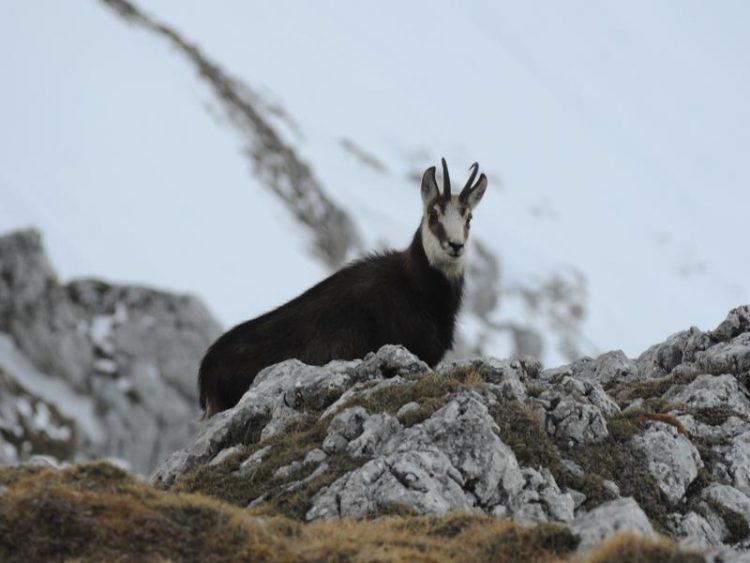Cause of death established – Chamois had pneumonia

Two different strains of bacteria caused the sudden chamois-deaths. Photo: A. Haymerle
Chamois (Rupicapra rupicapra) share their habitat with a number of other wild animals as well as with farm animals. Because of the risk of disease transmission between species, when dead or sick animals are discovered by hunters or foresters it is extremely important determining the causes. Early identification of the cause of disease or death can be crucial to prevent a wide-scale outbreak. The Pathological Laboratory at the Research Institute of Wildlife Ecology specializes in such cases.
Severe pneumonia as cause of death
Nineteen dead chamois from the region of Amstetten, Lilienfeld and Salzburg in north-central Austria were investigated. The researchers performed autopsies, investigating various tissues and testing for the presence of bacteria, viruses and parasites. The analysis revealed that the animals had died of a massive pneumonia.
The causes of the pneumonia turned out to be bacteria with the evocative names Mannheimia glucosida (in honour of the German biologist Walter Mannheim, nothing to do with the German town) and Bibersteinia trehalosi. The bacteria had previously been detected only in cattle and sheep. That they can cause deadly and epidemic pneumonia in chamois was unknown. “It is against the law to administer medical treatment to wild animals, so we don’t really have many possibilities to prevent an epidemic”, explains Annika Posautz from the pathology team of the Research Institute. “All we can do is try to minimize contact between animals, for example by avoiding the use of salt licks.”
There has been no acute die-off of chamois since the cases in 2010. So why were the bacteria so harmful at that time? Posautz believes that “It was probably a combination of several factors. The winter of 2009-2010 was very harsh and the animals were suffering from parasite infestation. The combination of these two factors weakened their immune systems and probably led to the deaths.”
Threat to domestic animals
In the Alps, chamois are frequently in close contact with domestic animals such as cattle and sheep that graze in the pastures. This puts farm animals as well as wildlife population at risk for inter-species transmission of infections. Close cooperation with hunters and foresters is essential to ensure that any outbreaks are detected as soon as possible. It is then possible to put emergency measures in place, including increased monitoring of the animals and actions to minimize contact between diseased and healthy individuals.
The article „Acute die-off of chamois (Rupicapra rupicapra) in the eastern Austrian Alps due to bacterial bronchopneumonia with Pasteurellaceae”, by Annika Posautz, Igor Loncaric, Anna Kübber-Heiss, Alexander Knoll and Christian Walzer was published in the Journal of Wildlife diseases. DOI: 10.7589/2013-04-090 http://www.jwildlifedis.org/doi/abs/10.7589/2013-04-090
About the University of Veterinary Medicine, Vienna
The University of Veterinary Medicine, Vienna in Austria is one of the leading academic and research institutions in the field of Veterinary Sciences in Europe. About 1,200 employees and 2,300 students work on the campus in the north of Vienna which also houses five university clinics and various research sites. Outside of Vienna the university operates Teaching and Research Farms. http://www.vetmeduni.ac.at
Scientific Contact:
Annika Posautz
Research Institute of Wildlife Ecology
University of Veterinary Medicine, Vienna (Vetmeduni Vienna)
T +43 1 25077-7156
annika.posautz@vetmeduni.ac.at
Released by:
Dr.rer.nat. Susanna Kautschitsch
Science Communication / Public Relations
University of Veterinary Medicine, Vienna (Vetmeduni Vienna)
T +43 1 25077-1153
susanna.kautschitsch@vetmeduni.ac.at
http://www.vetmeduni.ac.at/en/infoservice/presseinformation/press-releases-2014/…
Media Contact
All latest news from the category: Agricultural and Forestry Science
Newest articles

New model of neuronal circuit provides insight on eye movement
Working with week-old zebrafish larva, researchers at Weill Cornell Medicine and colleagues decoded how the connections formed by a network of neurons in the brainstem guide the fishes’ gaze. The…

Innovative protocol maps NMDA receptors in Alzheimer’s-Affected brains
Researchers from the Institute for Neurosciences (IN), a joint center of the Miguel Hernández University of Elche (UMH) and the Spanish National Research Council (CSIC), who are also part of…

New insights into sleep
…uncover key mechanisms related to cognitive function. Discovery suggests broad implications for giving brain a boost. While it’s well known that sleep enhances cognitive performance, the underlying neural mechanisms, particularly…



